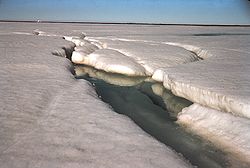Arctic Environmental Protection Strategy

The Arctic Environmental Protection Strategy (AEPS) (sometimes referred to as the Finnish Initiative)[1] is a multilateral, non-binding agreement[2] among Arctic states on environmental protection in the Arctic. Discussions began in 1989, with the AEPS adopted in June 1991 by Canada, Denmark, Finland, Iceland, Norway, Sweden, the Soviet Union, and the United States. The AEPS deals with monitoring, assessment, protection, emergency preparedness/response, and conservation of the Arctic zone.[3] It has been called a major political accomplishment of the post–Cold War era.[4]
Background
In January 1989, Finland sent a letter to the other Arctic states proposing a conference on protection of the Arctic
Adoption
Government officials from all the Arctic nations convened in Rovaniemi in June 1991 for the last consultative meeting. The first three days included meetings, followed by a ministerial-level meeting on 13–14 June observed by representatives from Germany, Poland, the United Kingdom, and the United Nations.
Three
On 14 June 1991, the AEPS and the Declaration on the Protection of the Arctic Environment ("Rovaniemi Declaration") were formally adopted.[7] The main objectives were listed as,
"Preserving environmental quality and natural resources, accommodating environmental protection principals with the needs and traditions of Arctic Native peoples, monitoring environmental conditions, and reducing and eventually eliminating pollution in the Arctic Environment."[1]
Follow-up
The AEPS outlined five objectives and six pollution issues.[8] Legal issues included its jurisdictional reach and extent of obligations for the member states.[9] Data-gathering, information compilation, and assessment tasks were organized around these issues.[10]
In their 1993 follow-up meeting in Nuuk, Greenland, ministers endorsed expanding the AEPS in order to deal with sustainable development,[3] and issued the Nuuk Declaration.[11] Another meeting occurred in 1996 in Ottawa, Canada, resulting in the Ottawa Declaration (1996) and the establishment of the Arctic Council.[12] The last meeting, held in 1997 in Alta, Norway[10] following the AEPS's 1996 absorption into the Arctic Council resulted in the Alta Declaration.[13]
The AEPS remains a strategy for the Council's working groups,[14] including:[2]
- Arctic Monitoring and Assessment Programme (AMAP)
- Conservation of Arctic Flora and Fauna (CAFF)
- Protection of the Arctic Marine Environment (PAME)
- Emergency, Prevention, Preparedness and Response (EPPR)
- Sustainable Development and Utilization (SDU)
Criticism
Critics of the Arctic Environmental Protection Strategy argue that it:
- Lacks ongoing political attention and direction, along with financial commitment.[3]
- Lacks the legal authority of a treaty.[15]
- Involves studies and talks but lacks concrete action.[16]
- Does not address specific problems, for example, Arctic haze.[17]
See also
References
- ^ OCLC 227865174.
- ^ a b c Russell, Bruce A. "The Arctic Environmental Protection Strategy & the New Arctic Council". Archived from the original on 11 October 2008. Retrieved 2008-09-23.
- ^ a b c "The Arctic Environmental Protection Strategy". carc.org. Archived from the original on 2006-10-07. Retrieved 2008-09-23.
- ISBN 1-55963-235-6.
Arctic Environmental Protection Strategy .
- ^ Rothwell, p. 231
- ^ Tennberg, Monica (December 1996). "CONTRIBUTING TO THE AEPS: INDIGENOUS KNOWLEDGE". Northern Notes. IV. uconn.edu: 21–32. Archived from the original on 11 October 2008. Retrieved 2008-09-23.
- ISBN 0-521-56182-5.
- ^ Rothwell, p. 234
- ^ Rothwell, p. 238
- ^ ISBN 0-521-66311-3.
- ^ Ministers of the Arctic Countries (1993-09-16). "The Nuuk Declaration". npolar.no. Archived from the original on 2012-07-07. Retrieved 2008-09-23.
- ^ Global Environment Outlook-1 (1997). "Chapter 3: Policy Responses and Directions". United Nations Environment Programme, Global State of the Environment Report. nies.go.jp. Archived from the original on 2005-03-10. Retrieved 2008-09-23.
{{cite web}}: CS1 maint: numeric names: authors list (link) - ^ Ministers of the Arctic countries (1997-06-13). "The Alta Declaration". npolar.no. Archived from the original on 2012-07-08. Retrieved 2008-09-23.
- ISBN 2-8317-0637-8.
- ^ Pfirman, S.L.; Hajost, S.A.; Crane, K. (1992-12-29). "We Have to Protect No-Longer-Pristine Arctic". The New York Times. Retrieved 2008-09-23.
- ISBN 90-411-1648-6.
- ISBN 0-8014-8069-8.
